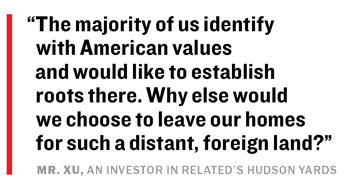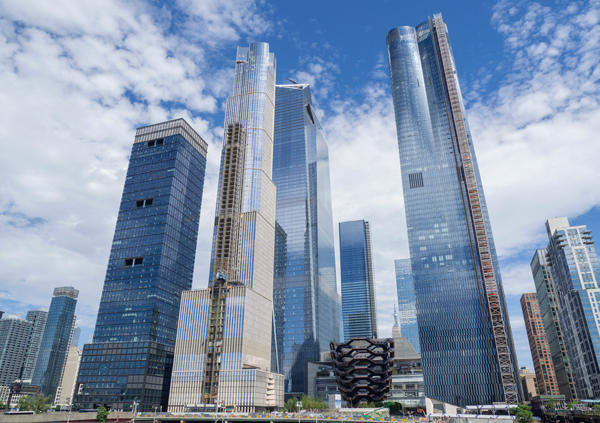They would be known to each other only by their noms de guerre: Mecky, Mr. Xu, Julie, Mr. Li, Richard, Jenny and Big Sis.
When the seven EB-5 investors gathered at the Eddington House cafe in Shanghai, known as a favorite haunt of the essayist Eileen Chang during the pre-revolutionary era, it was the first time any of them had met in person — although they had been in contact on WeChat for months.
For privacy, they swore one another to secrecy. Some were concerned about the political atmosphere in China. Expressing a desire to emigrate could be problematic, especially for those with high-level government connections.
The urbane Chinese citizens were all members of a group that called itself EB5 Association of Investors, or EB5AI, which formed last spring to represent the interests of investors lobbying for EB-5 reform. On a Saturday afternoon in late October, The Real Deal met with seven of them in Shanghai to learn about their experiences with the federal program and their thoughts on what was to come.
Each had invested $500,000 — with that money going into a wide variety of projects across the United States — and they all faced a common dilemma: a decade-long backlog. Following a few boom years in the mid-2010s, the expected wait time for a Chinese investor who applies for an immigration visa through the EB-5 program today has ballooned to 16 years, according to the latest statistics from the U.S. State Department.
This situation has been damaging for all segments of the EB-5 food chain, including real estate developers and intermediaries in the States, who are now facing additional pressure from federal rule changes introduced late last year — upping the minimum investment required, and restricting areas where that minimum applies.
“The business has really declined substantially as a result of the situation with the backlog, because Chinese investors are not coming forward, and they always provided the bulk of the people,” said Ira Kurzban of Miami-based immigration law firm Kurzban Kurzban Tetzeli and Pratt, who filed a class action lawsuit on behalf of EB-5 investors against the Department of State in 2018, challenging federal policies that have contributed to the backlog.
EB-5 industry insiders in the U.S. have been able to find powerful allies such as Sen. Lindsey Graham, who is co-sponsoring a bill to ease some of the new restrictions. But the tens of thousands of backlogged investors in China — the ultimate source of billions of dollars for the U.S. real estate industry each year — have found themselves in a dreadful position half a world away, and with few options at their disposal.
So when TRD proposed meeting with some of them in person, many were eager to take the opportunity, but with some reservations. For this reason, the investors are referred to here by either their surnames or Western first names they’ve adopted, and some information that might lead to the identification of individual investors has been omitted. This is their story.
“We’re the elite”
 While other EB-5-focused interest groups have been formed by regional centers in the U.S., the members of EB5AI saw their group’s role as representing investor interests in particular, which might not always be in line with the intermediaries who invested their money on their behalf. For the investors, the first order of business was to dispel what they saw as likely misconceptions about Chinese participants in the EB-5 program.
While other EB-5-focused interest groups have been formed by regional centers in the U.S., the members of EB5AI saw their group’s role as representing investor interests in particular, which might not always be in line with the intermediaries who invested their money on their behalf. For the investors, the first order of business was to dispel what they saw as likely misconceptions about Chinese participants in the EB-5 program.
“We’re not tuhao,” the investor who called herself Jenny said on behalf of the group — using the Chinese term for a type of extravagant nouveau riche that had emerged during the country’s economic reform, often through unscrupulous business practices or government ties.
“We’re the elite,” Jenny added, pointing to the fact that all investors present had received a university education. She herself was a retired engineer.
“More importantly, the majority of us identify with American values and would like to establish roots there,” said Xu, who works as an executive at a multinational corporation in Shanghai. “Why else would we choose to leave our homes for such a distant, foreign land?”
A win-win?
Chinese interest in the EB-5 program began to skyrocket in 2014, the same year the Canadian government put an end to its own decades-old Immigrant Investor Program. Canada’s Ministry of Finance had found that the program “significantly undervalued” permanent residence in the country without generating economic returns.
Emigration agencies in China, for whom the Canadian program had long been a cash cow (it had its own six-year backlog of 65,000 pending applications at the time of its cancellation), quickly pivoted south to the United States, just as American real estate developers were facing a financing crunch in the wake of the Great Recession.
“The program became a way to help builders get money, which became very tight after 2008,” said Kurzban, the immigration lawyer. “It was kind of a perfect situation in which all three sides [developers, investors and intermediaries] benefited.”
The investors who spoke with TRD in Shanghai were all part of this wave, which lasted from 2014 through 2017. Xu recalled first hearing about the EB-5 program around 2008, but had no interest in pursuing it at the time. Only in 2015, amid “fluctuations” in his work situation, did he consider a move to the U.S., where he had studied in the late 1990s.
Jenny, who decided to invest in EB-5 in 2014 and spent a year choosing the right project, had heard stories about “really rich” Chinese investors who had gone the EB-5 route before it was cool. But she said most have since given up U.S. residency to avoid being taxed on their worldwide income.

Hudson Yards
For several of these investors, obtaining U.S. residency for their children was a key consideration. Jenny’s son had stayed with a host family in Virginia during high school, and had become very attached to the American lifestyle. “They were a Korean-American family,” Jenny recalled. “Very nice people, they fed him so well!”
Julie, an architect and mother of two who traveled from Hangzhou for the meeting, had a similar motive. Her elder son stayed first with a family in Chicago for a year, and then with a family in Oregon. And Li, a small-business owner, has a daughter who is studying film in Los Angeles, not far from the project that he invested in.
Compared to other means of obtaining residency in the U.S., the EB-5 route appeared to present a number of advantages.
First of all, investors could apply for residency without already being in the U.S. — not a bad arrangement for someone with a well-paying urban white-collar job or private business in China.
Secondly, in contrast to the lottery system that is used to select H-1B visa applicants, the EB-5 program appeared to offer greater certainty — for a price.
“Chinese investors in particular were drawn to the EB-5 program because it enabled them to obtain green cards in an expedited manner for their families,” said Pierre Debbas, a partner and founding member of real estate law firm Romer Debbas LLP.
“Many of these investors wanted their children to attend college in the U.S., thus making the program more appealing compared to perhaps similar programs in other countries,” he added.
For comparison, the U.K.’s investor visa program requires a minimum investment of 2 million pounds, while its Australian counterpart costs 5 million Australian dollars (about $3.4 million). And while Canada’s national investor visa program has been abolished, the province of Quebec offers a similar deal for an investment of 1.2 million Canadian dollars.
Compared with these options, the EB-5 program’s $500,000 threshold seemed like a real bargain — and a much more attainable goal for upper-middle-class Chinese investors.
From boom to boom
In retrospect, a large chunk of the EB-5-driven real estate development boom in the U.S. was driven by an even more dramatic real estate boom (or bubble, some might say) in China — specifically, the market for residential real estate in China’s major cities.
Apartment prices in cities like Shanghai and Beijing have more than doubled over the past decade, and urban homeownership rates in China are among the highest in the world, at around 90 percent. Faced with limited investment alternatives, ownership of second or even third homes — often left empty — has also become increasingly common.
Emigration-minded urban middle-class Chinese were in the perfect position to benefit from this boom, and the relatively low investment threshold of half a million dollars — unchanged since 1990 — meant that many investors were able to secure the necessary EB-5 funds just by cashing out of their apartments.
With the exception of one investor who sourced funds from his family business, the group that met with TRD all funded the bulk of their investments by either selling or taking out mortgages on their homes.

While sourcing funds, the investors also set out to find a migration agent and select a project to invest in. Most went with one of the big franchises in the business — Huijia, Wailian and Shimaotong, to name a few.
But Mecky, an engineer turned housewife, relied on the services of an acquaintance — a former journalist who changed careers to become one of the hundreds of mom-and-pop EB-5 migration agents operating in China at the time. Migration consulting had become a very lucrative business, with agencies pulling in as much as 40 percent of each investment’s value in fees.
The investors took varied approaches to selecting their projects. Richard, a small-business owner with many relatives in the U.S., and Xu both became investors in the poster child of the EB-5 boom, the Related Companies’ Hudson Yards megadevelopment.
Richard was able to secure a 4 percent interest rate for his investment, and he made a point of inspecting the site in person on a visit to New York City. Xu, meanwhile, agreed to make a no-interest investment.
Jenny, who spent a full year searching for a project to invest in, even sent her son to examine a site in New Jersey. She eventually settled on a hotel development in a different part of the country altogether.
Big Sis chose an infrastructure project, the construction of a connection between the Pennsylvania Turnpike and I-95, and said the fact that it was a government project — with what was at times portrayed as a “government guarantee” — contributed to the decision. “It seemed a bit too good to be true,” she noted.
With their investment funds secured and deployed, all the investors had to do was wait. But none expected to wait so long.
A spokesperson for the regional center behind the Pennsylvania Turnpike project said every investor received a private memorandum and limited partnership agreement that clearly explained “the nature of the investment.”
The Delaware Valley Regional Center spokesperson also noted that the “Pennsylvania Turnpike Commission borrowed a total of $383 million” and that the project’s senior debt is “rated A+ by S&P.”
Moment of truth
Jenny, the retired engineer, first heard about the EB-5 visa backlog in fall 2017, at a Mid-Autumn Festival gala hosted by her migration agency, Shimaotong.
“The young lady at the agency office called me several times to remind me to attend,” she recalled. “Looking back, I feel like there was something she really wanted me to know, something that she couldn’t tell me directly.”
After meeting with fellow EB-5 investors at the event, she realized the severity of the situation.
“I had looked at how long people who invested before me had had to wait, and just assumed that that would be my wait time as well,” she said. Other investors said that they had a similar mindset.
In fact, the pipeline of Chinese investors waiting to apply for immigration visas had already been clogged up for years by that point.

Rendering of Four Seasons Cayo Largo in Puerto Rico
The “final action date” for mainland Chinese EB-5 investors was Nov. 22, 2014, as of this January, according to the U.S. State Department’s latest monthly visa bulletin. That means someone who invested on that date, just a few months into the boom, might have become eligible to apply for an immigration visa only recently, more than five years down the line.
Data disclosed by U.S. Citizenship and Immigration Services in 2018 in response to a Freedom of Information request shows that 109 visa applications submitted by mainland Chinese citizens in 2014 were still pending four years later. That number ballooned to 710 in 2015, 2,444 in 2016 and 3,621 in 2017.
But in 2017, people still held out hope. “A lot of investors were looking for signs of reform,” Richard said, noting many people were confident that new legislation would resolve the backlog before it got out of hand.
American promoters of EB-5 projects warned hesitant investors that the cost of investment would go up soon (as did eventually happen in late 2019), and argued that it was better to secure a spot in the line now than to wait for the backlog to be cleared later.
At this point, Chinese investors had already sunk an estimated $16 billion into the EB-5 program, much of which will eventually need to be redeployed into other ventures in order to keep the investments “at risk.”
“There were a lot of silly people with money to spare who fell victim to a fallacious way of thinking,” Xu said, including himself in this criticism. “And some people got lazy and decided they’d just wait in line and see what happened.”
“By 2018 I realized the backlog was a serious issue, and by 2019 I started to think it might be an unsolvable problem,” he added.
The way migration agencies handled the slow-brewing crisis exacerbated matters. Xu observed that “the agencies were clearly trying to split investors up” and prevent them from organizing.
While things were going well, many agencies had set up groups on WeChat to share project updates with investors. Some U.S. developers also set up Chinese-language WeChat accounts and arranged face-to-face meetings with investors. But the transparency started to slip as more and more investors began asking questions about the backlog.
Big Sis, the investor in the Pennsylvania Turnpike project, was added to a WeChat group with more than 500 people, which had been set up by the agency handling her investment.
“People kept asking for more information about what was going on, and the agency kept saying, ‘It’s too soon to tell for sure,’” she recalled. “Then one day they finally admitted that there was a serious problem, and they deleted the group the next day.”
The EB-5 endgame
Making significant changes to 30-year-old immigration legislation from the other side of the world is a tall task, but the members of EB5AI have identified a few courses of action.

West Hollywood Marriott Edition Hotel
The first is lobbying for legislative changes, a cause that individual investors can contribute to either by donating funds or by taking the fight to social media. As TRD has previously documented, large numbers of investors have taken to tweeting memes at U.S. politicians in an effort to draw attention to their plight.
The Chinese government’s censorship of the internet makes this slightly trickier, but motivated investors can easily learn to circumvent it with a VPN. And if they happen to work for a foreign company that has unfettered access to the World Wide Web, they can simply tweet on the job.
The second approach is as American as apple pie: suing. Xu, for example, has thrown his support behind Kurzban’s class action lawsuit against the U.S. State Department, which, if successful, would achieve some of the main goals of legislative reform.
“We’re hoping that one way or the other, we’ll get rid of counting derivatives, which is kind of a ridiculous practice that’s made up by the State Department,” Kurzban said, referring to the department’s practice of counting family members toward the annual visa quota, instead of just the primary applicant-investors themselves. “I don’t think the statute says what the government is saying it says.”
The class action has already faced one setback, as a judge denied the plaintiffs’ motion for a preliminary injunction and temporary restraining order against the State Department in December 2018. The court has yet to make a decision on the department’s motion to dismiss the case outright.
“It’s difficult to predict, but it doesn’t look completely positive,” Kurzban said. “But if we don’t prevail, we’ll appeal it.”
Meanwhile, the investors said they expect many more EB-5 lawsuits to surface in the coming year. Given the five-year term typical of EB-5 investments, 2020 is a year in which large numbers of investors will likely begin demanding their money back.
“If it’s no longer possible for us to get residency, then my bottom line is that I absolutely want my investment back,” said Li. “Emigrating to America was a dream of mine, but if that can’t happen, I might just go back to my home village” in southern Zhejiang province, he added.
Investors noted that the uncertainty around the backlog had made career and family planning impossible, as parents faced the possibility of receiving U.S. residency while their children had already “aged out.”
“There’s no clear way forward, and no way back either,” Li said.
At the same time, EB-5 intermediaries and Chinese migration agencies have both moved on to newer, easier targets. While regional centers are increasingly sourcing funds from Vietnam, India and Latin America, Chinese migration agencies are now trying to sell prospective emigrants on other “golden visa” programs around the world, everywhere from St. Kitts and Nevis to Vanuatu.
Greece, which established an investor visa program in 2013, was recently one of the top destinations for Chinese investors looking for European residency. And following the recent economic crash in neighboring Turkey, agencies have begun touting that country as a cheaper alternative.
“As far as I can remember, this is the first time Chinese migration agencies have tried convincing people to move to a country with an active war raging on its borders,” said EB-5 industry observer Connor Chen, who runs the widely read EB5Sir blog.
For their part, however, the EB5AI investors who met with TRD said they had never considered emigrating anywhere besides the U.S. “Canada, New Zealand and Australia all just seem too small,” Richard quipped.
Others in the group echoed that sentiment.
“When we chose to invest in the EB-5 program, we were assured by the fact that this was a federal program operated by a well-run government whose values we admired,” Julie said. “For many of us, the mismanagement of EB-5 has led to a lot of disappointment and disillusionment with the United States.”

